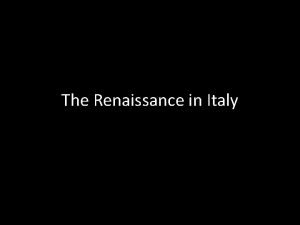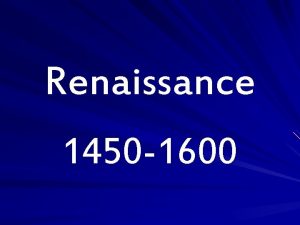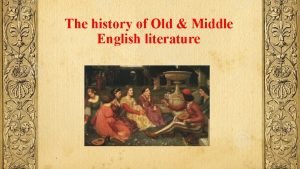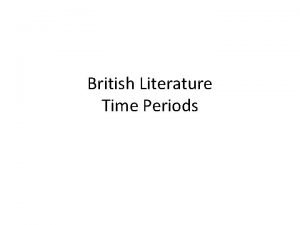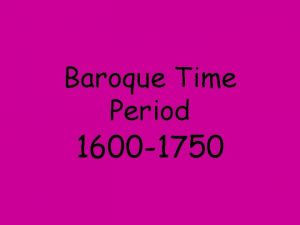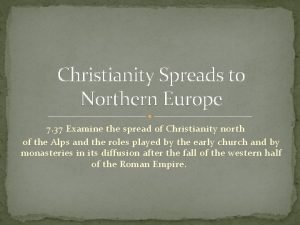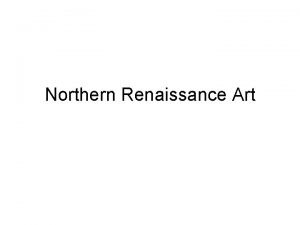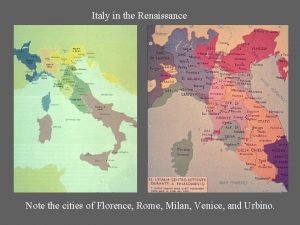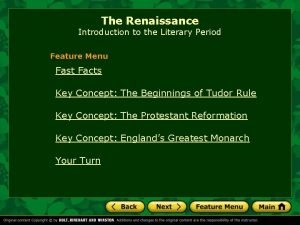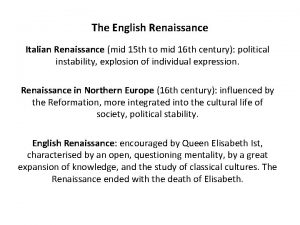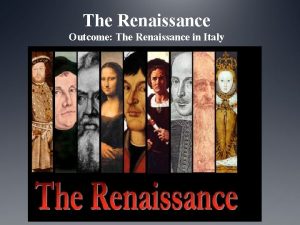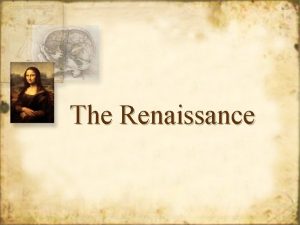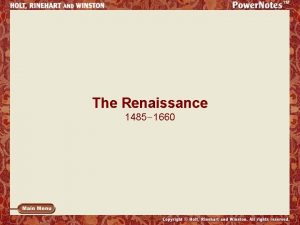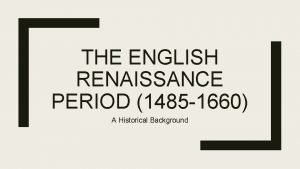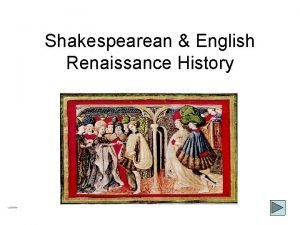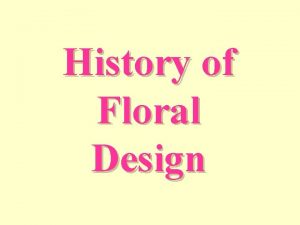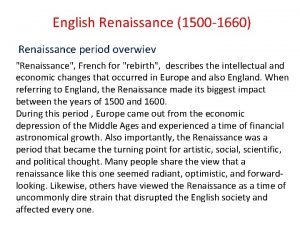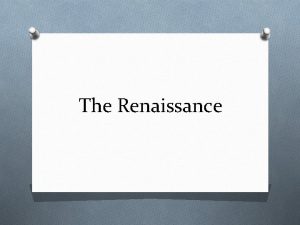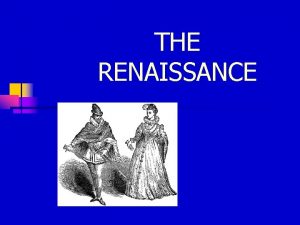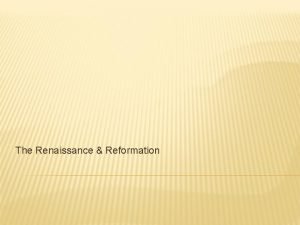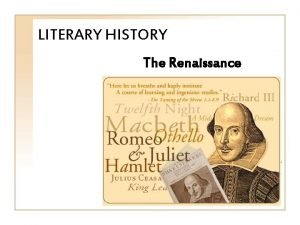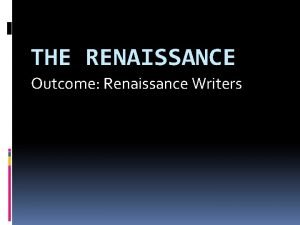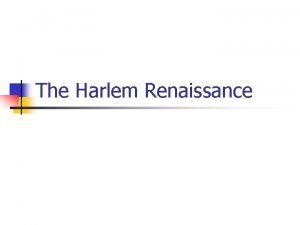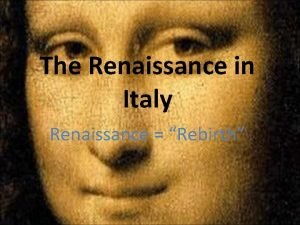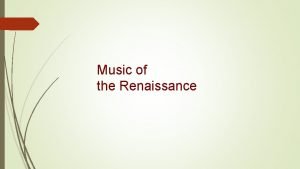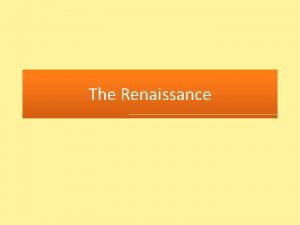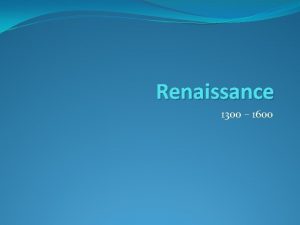The Renaissance Period A Historical Summary of the















![References Famous Scientists. (2014). [Illustration of Claudius Ptolemy’s Universe]. Ptolemy’s Universe. Retrieved on 12/4/16 References Famous Scientists. (2014). [Illustration of Claudius Ptolemy’s Universe]. Ptolemy’s Universe. Retrieved on 12/4/16](https://slidetodoc.com/presentation_image/28af747ee50a8aba94c517e524033c1d/image-16.jpg)
![References (cont’d) Lenny. Bound. (2009, January 13). Cogito Ergo Sum [Video File]. Retrieved from References (cont’d) Lenny. Bound. (2009, January 13). Cogito Ergo Sum [Video File]. Retrieved from](https://slidetodoc.com/presentation_image/28af747ee50a8aba94c517e524033c1d/image-17.jpg)

- Slides: 18

The Renaissance Period A Historical Summary of the Movement and its Key Players Learning Objectives • Given a choice of paintings / sculptures, student will be able to identify which paintings / sculptures were created by which artists This presentation may contain material protected under copyright law. This material was obtained and used following a reasoned analysis of Fair Use exemption for educators. This presentation may not be reproduced. • Student will be able to answer general questions (time period, identification of major players) about the Renaissance Period Click the “home” or “menu” button to get started!

The Renaissance Period Lesson Menu Learner Instructions 1. First, go through each item under “Introduction” to obtain background information and take the QUIZ 2. Then, go through each of the Major Players of Science (no specific test / quiz for this section) 3. Finally, go through each of the Major Players of Art (after each one, there is a matching game to play to test your knowledge) Introduction Major Players Art Science QUIZ More Overview of the Renaissance Nicholaus Copernicus Leonardo Da Vinci Other Resources VIDEO – Introduction to the Renaissance Period Rene Descartes Raphael Go to Reference Slide Test Your Knowledge Before Moving on! Galileo Galilei Michelangelo REFERENCES I’M DONE! End the Show.

Overview of the Renaissance Summary: Known as the Renaissance, the period immediately following the Middle Ages in Europe saw a great revival of interest in the classical learning and values of ancient Greece and Rome. Against a backdrop of political stability and growing prosperity, the development of new technologies–including the printing press, a new system of astronomy and the discovery and exploration of new continents–was accompanied by a flowering of philosophy, literature and especially art. The style of painting, sculpture and decorative arts identified with the Renaissance emerged in Italy in the late 14 th century; it reached its zenith in the late 15 th and early 16 th centuries, in the work of Italian masters such as Leonardo da Vinci, Michelangelo and Raphael. In addition to its expression of classical Greco-Roman traditions, Renaissance art sought to capture the experience of the individual and the beauty and mystery of the natural world. Facts • Time Period: between 14 th and 16 th centuries • Period Followed: followed a period called the Middle Ages, known for its dark traditions and imagery • Location: Europe with Italy becoming a central home for Renaissance pursuits • Cultural Advancements • Science: brought about new system of astronomy and discovery of new continents • Arts: focus on paintings with linear perspective, depth and more mathematically correct representations Click the “home” or “menu” button to move to the next step

Video (~8 minutes) https: //www. youtube. com/watch? v=xf 2 G 2 Il 8 crw

Nicholaus Copernicus Summary Key Discoveries / Works Nicolaus Copernicus was a Renaissance mathematician and astronomer who formulated a model of the universe that placed the Sun rather than the Earth at the center of the universe. The publication of this model just before his death in 1543 is considered a major event in the history of science, triggering the Copernican Revolution and making an important contribution to the Scientific Revolution. • 1543: 'De Revolutionibus Orbium Coelestium' ('On the Revolutions of the Celestial Spheres') -- the Earth rotates daily on its axis and revolves yearly around the sun. He also argued that the planets circled the Sun (see below). Old View (Ptolemy’s Universe) Fast Facts • Born: February 19, 1473, Toruń, Poland • Died: May 24, 1543, Frombork, Poland • Education: University of Padua (1501– 1503) Click “next” to go to the next scientist, Rene Descartes New View (Copernicus)

Rene Descartes Summary Key Discoveries / Works René Descartes was a French philosopher, mathematician, and scientist. Dubbed the father of modern western philosophy, much of subsequent Western philosophy is a response to his writings, which are studied closely to this day. Descartes was a scientist at heart and used science to explore his ideas. He set out to trust only that which is clearly and distinctly seen to be beyond any doubt. Anything that could be doubted was rejected. • Second Meditation – Descartes makes the famous statement “Cogito, ergo, sum, ” which means “I think, therefore I am. ” Cogito, Ergo, Sum VIDEO Fast Facts • Born: March 31, 1596, Descartes, Indre-et-Loire, France • Died: February 11, 1650, Stockholm, Sweden • Influenced: Noam Chomsky, Baruch Spinoza, Slavoj Žižek • Influenced by: Aristotle, Plato, Thomas Aquinas, Archimedes https: //www. youtube. com/watch? v=QE 8 d. L 1 Swe. Cw Click “next” to go to the next scientist, Galileo Galilei

Gallileo Galilei Summary Key Discoveries / Works Considered the father of modern science, Galileo Galilei made • “Dialogue Concerning the Two Chief World Systems” – book about major contributions to the fields of physics, astronomy, cosmology, Copernicus’ heliocentric universe theory mathematics and philosophy. He invented an improved telescope • Invention of the Telescope that let him observe and describe the moons of Jupiter, the rings of Saturn, the phases of Venus, sunspots and the rugged lunar • Sidereus Nuncius (“Starry Messenger”) -- It was the first published scientific surface. His advocacy of a heliocentric universe (see Copernicus) work based on observations made through a telescope brought him before religious authorities in 1616 and again in 1633, when he was forced to recant and placed under house arrest for Dialogue Concerning the rest of his life. Fast Facts • Born: February 15, 1564, Pisa, Italy • Died: January 8, 1642, Arcetri • Education: University of Pisa (1581– 1585) • Discovered: Callisto, Europa, Ganymede, Rings of Saturn Go to “main menu” the Two Chief World Systems Gallileo’s Telescope Sidereus Nuncius

Leonardo Da Vinci Summary Leonardo da Vinci was a painter, architect, inventor, and student of all things scientific. His natural genius crossed so many disciplines that he epitomized the term “Renaissance man. ” Art, da Vinci believed, was indisputably connected with science and nature. Largely self-educated, he filled dozens of secret notebooks with inventions, observations and theories about pursuits from aeronautics to anatomy. LEARNER Click on Leonardo to take a quick quiz Key Discoveries / Works Mona Lisa (1503– 06, The Louvre, Paris) The Last Supper (late 1490’s, Santa Maria delle Grazie in Milan, Italy) Fast Facts • Born: April 15, 1452, Anchiano • Died: May 2, 1519, Amboise, France • Buried: Chapel of Saint-Hubert Vitruvian Man (1490, Gallerie dell'Accademia, in Venice, Italy)

LEARNERS Click on Raphael to take a quick quiz Raphael Summary Raphael was an Italian painter and architect of the High Renaissance period, best known for his Madonnas and for his large figure compositions in the Vatican in Rome. Most of his work was produced in the Vatican Palace, there you will find the frescoed Raphael Rooms and these were amongst his greatest and largest bodies of work. He was greatly admired for his clarity of form and described as having serene and harmonious quality to his work, Raphael worked for two popes, Pope Julius II and the Medici Pope Leo X. Key Discoveries / Works The School of Athens (1509 – 1511, Apostolic Palace, Vatican City) Sistine Madonna (1512, Gemäldegalerie Alte Meister, Dresden) Fast Facts • Born: 1483, Urbino, Italy • Died: April 6, 1520, Rome, Italy • Full name: Raffaello Sanzio da Urbino • Buried: Pantheon, Rome, Italy The “angels” in this painting are found frequently as copied works on their own

LEARNERS Click on Michelangelo to take a quick quiz Michelangelo Summary Michelangelo was a sculptor, painter and architect widely considered to be one of the greatest artists of the Italian Renaissance period—and arguably of all time. His work demonstrated a blend of psychological insight, physical realism and intensity never before seen. His resulting work, most notably his Pietà and David sculptures and Sistine Chapel ceiling paintings, has been carefully tended and preserved, ensuring that future generations would be able to view and appreciate Michelangelo’s genius. Key Discoveries / Works The David (1501 – 1504, Galleria dell'Accademia, Florence) Ceiling of the Sistine Chapel (1508 – 1512, Sistine Chapel, Vatican City) Sistine Madonna Fast Facts • Born: March 6, 1475, Caprese Michelangelo, Italy • Died: February 18, 1564, Rome, Italy • Buried: Santa Croce, Florence, Italy Pieta (1498 – 1499, St. Peter’s Basilica, Vatican City)

Click on Leonardo if you need to review his information The Matching Game Click on the 3 paintings / drawings produced by Leonardo Da Vinci! OOPS! – TRY AGAIN YES! AFTER taking the Quiz, go to Raphael YES! OOPS! – TRY AGAIN

Click on Raphael if you need to review his information The Matching Game Click on the 2 pics below produced by Rafael! YES! OOPS! TRY AGAIN AFTER taking the Quiz, go to Michelangelo OOPS! TRY AGAIN YES! OOPS! TRY AGAIN

The Matching Game Click on Michelangelo if you need to review his information Click on the 3 pics below produced by Michelangelo! YES! OOPS! TRY AGAIN AFTER taking the Quiz, go back to “Home” OOPS! TRY AGAIN YES!

Quiz on Intro Material Click on the answer to each question below. GOOD LUCK! YES! 1. True or False: The Renaissance Period followed the Middle Ages. True False 14 th to 16 th 18 th to 20 th YES! 2. During what centuries was the Renaissance? 4 th to 6 th YES! 3. Which family was very influential during the Renaissance? Kardashians Von Trapps Medici Picasso Raphael Da Vinci Perspective Color YES! 4. Which famous artist was NOT part of the Renaissance? YES! 5. What new innovation in art occurred during the Renaissance? 2 -D When complete, return to menu page and start reviewing the “Major Players”

Other Resources https: //www. khanacademy. org/humanities/art-history-basics/art-1010 ddp/v/renaissance-art-introduction http: //arthistorysummerize. info/Art. /the-renaissance/ http: //www. italian-renaissance-art. com/ https: //en. wikipedia. org/wiki/Renaissance http: //www. oxfordartonline. com/public/page/themes/renaissanceartandarchit ecture http: //www. historyworld. net/wrldhis/Plain. Text. Histories. asp? Paragraph. ID=fbx
![References Famous Scientists 2014 Illustration of Claudius Ptolemys Universe Ptolemys Universe Retrieved on 12416 References Famous Scientists. (2014). [Illustration of Claudius Ptolemy’s Universe]. Ptolemy’s Universe. Retrieved on 12/4/16](https://slidetodoc.com/presentation_image/28af747ee50a8aba94c517e524033c1d/image-16.jpg)
References Famous Scientists. (2014). [Illustration of Claudius Ptolemy’s Universe]. Ptolemy’s Universe. Retrieved on 12/4/16 from http: //www. famousscientists. org/nicolaus-copernicus/ Famous Scientists. (2014). [Illustration Taken from the book De Revolutionibus Orbium Coelestium]. Copernicus’ Heliocentric Universe. Retrieved on 12/4/16 from http: //www. famousscientists. org/nicolaus-copernicus/ Galileo Galilei. (2016, September 16). In Wikipedia, The Free Encyclopedia. Retrieved 17: 43, September 30, 2016, from https: //en. wikipedia. org/w/index. php? title=Galileo_Galilei&oldid=739766219 Goodbye-Art Academy. (2014, March 16). Renaissance – Overview [Video File]. Retrieved from https: //www. youtube. com/watch? v=xf 2 G 2 Il 8 crw History. com Staff. (2010). Galileo Galilei. Retrieved from http: //www. history. com/topics/galileo-galilei History. com Staff. (2010). Leonardo da Vinci. Retrieved from http: //www. history. com/topics/leonardo-da-vinci History. com Staff. (2010). Michelangelo. Retrieved from http: //www. history. com/topics/michelangelo History. com Staff. (2010). Renaissance Art. Retrieved from http: //www. history. com/topics/renaissance-art Kids Philosophy Slam. (2016). Philosopher of the Week: Rene Descartes. Retrieved from http: //www. philosophyslam. org/11_04. html
![References contd Lenny Bound 2009 January 13 Cogito Ergo Sum Video File Retrieved from References (cont’d) Lenny. Bound. (2009, January 13). Cogito Ergo Sum [Video File]. Retrieved from](https://slidetodoc.com/presentation_image/28af747ee50a8aba94c517e524033c1d/image-17.jpg)
References (cont’d) Lenny. Bound. (2009, January 13). Cogito Ergo Sum [Video File]. Retrieved from https: //www. youtube. com/watch? v=QE 8 d. L 1 Swe. Cw Leonardo da Vinci. (2016, September 16). In Wikipedia, The Free Encyclopedia. Retrieved 17: 43, September 30, 2016, from https: //en. wikipedia. org/w/index. php? title=Leonardo_da_Vinci&oldid=739698645 Michelangelo. (2016, September 25). In Wikipedia, The Free Encyclopedia. Retrieved 17: 41, September 30, 2016, from https: //en. wikipedia. org/w/index. php? title=Michelangelo&oldid=741171953 Nicolaus Copernicus. (2016, September 30). In Wikipedia, The Free Encyclopedia. Retrieved 17: 42, September 30, 2016, from https: //en. wikipedia. org/w/index. php? title=Nicolaus_Copernicus&oldid=741885977 Raphael. (2016, September 5). In Wikipedia, The Free Encyclopedia. Retrieved 17: 43, September 30, 2016, from https: //en. wikipedia. org/w/index. php? title=Raphael&oldid=737873214 René Descartes. (2016, September 28). In Wikipedia, The Free Encyclopedia. Retrieved 17: 43, September 30, 2016, from https: //en. wikipedia. org/w/index. php? title=Ren%C 3%A 9_Descartes&oldid=741567224

THANK-YOU!!! Created by Jeff Sant, 2016
 Meaning of renaissance
Meaning of renaissance Historical events in the renaissance
Historical events in the renaissance Old english period historical background
Old english period historical background The old english period
The old english period Historical events in baroque period
Historical events in baroque period Youth activism in 1970-72
Youth activism in 1970-72 The renaissance outcome the renaissance in italy
The renaissance outcome the renaissance in italy Italian renaissance vs northern renaissance venn diagram
Italian renaissance vs northern renaissance venn diagram The renaissance outcome renaissance painters/sculptors
The renaissance outcome renaissance painters/sculptors Flemish renaissance art characteristics
Flemish renaissance art characteristics Renaissance vs high renaissance
Renaissance vs high renaissance The renaissance introduction to the renaissance answer key
The renaissance introduction to the renaissance answer key Italian renaissance vs english renaissance
Italian renaissance vs english renaissance The renaissance outcome the renaissance in italy
The renaissance outcome the renaissance in italy What was renaissance
What was renaissance Renaissance time-line
Renaissance time-line The english renaissance period
The english renaissance period Dates of the renaissance
Dates of the renaissance French period floral design
French period floral design
